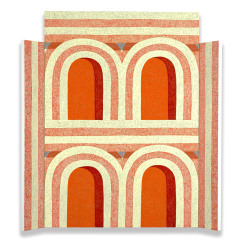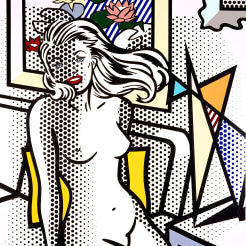Born on May 12, 1936 in Malden, Massachusetts, Frank Stella attended the Phillips Academy in Andover, Massachusetts from 1950 until 1954 and went on to Princeton University where he graduated with a B.A. in History in 1958. Frank Stella is one of the twentieth century's most innovative and productive artists.
Since 1960, when he completed his renowned series of "Black" paintings that startled the art world and heralded the advent of Minimalism, he has continually redefined the concerns of advanced painting and extended its boundaries. As a young artist, he addressed the formal aspects of modernism, focusing his attention on a picture's surface and structure. His approach was literal. "What you see is what you see" is how he explained his art in an often-quoted remark that set the tone for art-critical discourse in the sixties. Stella made emphatically flat paintings, which sought to excise illusionist space from the picture. In the "Black" paintings (included in the Museum of Modern Art's 1959 Sixteen Americans exhibition) and the "Aluminum" paintings which followed (his earliest shaped canvases, exhibited in this first solo show at the Leo Castelli Gallery in 1960) the picture's surface echoed and reiterated its depicted shape, reinforcing modernism's notion of painting's flatness as it sought to establish the painting as an object.
The most startling aspect of Stella's prolific career has been his remarkable ability to reinvent himself and his art. With the "Irregular Polygons" of 1966-67, Stella's attention shifted, and he began to explore the illusionist potential of abstraction; by 1973, with the completion of his "Polish Village" pictures (taking titles and shapes from the wooden synagogues destroyed by the Nazis) Stella seemed to have abandoned the anti-illusionist flat surfaces of his earlier paintings. For the artist they represented an entirely new direction – a move toward a projective, enveloping three-dimensional pictorial space. For the 1974-75 "Brazilian" series, he painted on etched metallic sheets formed into fan-like shapes; with the 1977-78 "Exotic Birds", he combined honeycomb aluminum with expressionistically worked ground glass surfaces. In the 1980's series "Circuits, Shards, South African Mines, Malta and Cones and Pillars" the paintings grew even denser, with overlapping, cut-out patterns that twisted into sinuous curves as the pictures moved forward into high relief. Every time Stella appears to have pushed painting to its limits he has redefined his art and renewed his ambitions. From 1986 until 1997 continuing his exploration of volumetric space in the "Moby Dick" series, Stella created 266 works, at least one for each of the 135 chapters of Herman Melville's great novel. From 1998 until 2002 Stella worked on another series based on the work of an author. The "Kleist" series titles come from the 19th Century writer Heinrich von Kleist and consist of works that range from small crisp wall reliefs named after Kleist's Love Letters to the massive Prince Frederick of Homburg, named for the play of that same title. All these series consist of metal reliefs, prints, monumental sculptures and murals.
As a sculptor, Stella has made massive metal pieces that are located in public places all over the world. One of his largest outdoor sculptures was commissioned by the National Gallery of Art in Washington, D.C. This piece, completed and installed in 2001, called Prince Frederick of Homburg (30 ½ feet tall and spans 47 feet at its widest) stands to the north of the IM Pei building facing the Capitol. As an architect, he has completed extensive scenographic decorations for the Princess of Wales Theater in Toronto and designed proposals for museums in Gronigen, Dresden and Buenas Aires. A brilliant 37 foot tall architectural structure that consists of twisting aluminum petals forming a proscenium, which appears to grow out of its oval base calling attention to Stella's attempt to tap the potential of organic and flexible form, has been recently completed in Cherbourg and can used as a band shell or stage. In his recent work, the lushly painted sand cast pieces of the "Near East" series and the stark simplicity of the unpainted bent aluminum pipe and trusses in the "Bamboo" series, Stella continues to move far beyond traditional painting's limits working freely in three dimensions.
The recipient of many honors and awards, Frank Stella is the only living painter to be honored with two retrospective painting exhibitions at the Museum of Modern Art. In 1983 he was appointed the Charles Eliot Norton Professor of Poetry at Harvard University; a year later, his lectures, titled "Working Space", were published in English, French and Japanese. In 1979 he was awarded the Claude M. Fuess Distinguished Service Award from Phillips Academy. He was the recipient of the Skowhegan award for Painting and the New York City Mayor's Award for Arts and Culture in 1981 and the Award of American Art from the Pennsylvania Academy of Fine Arts in 1985. He has received honorary degrees from Princeton University, Bezalel Academy in Jerusalem, Dartmouth College and Friedrich Schiller University in Jena, Germany. He received the Ordre des Arts et des Lettres from the French government in 1989. In 1992 he was awarded the Barnard Medal of Distinction. He was presented with the Gold Medal for Graphic Art award by the American Academy of Arts and Letters in 1998. In 2001 he received the Gold Medal of the National Arts Club in New York.
Stella lives and works in New York, NY.




